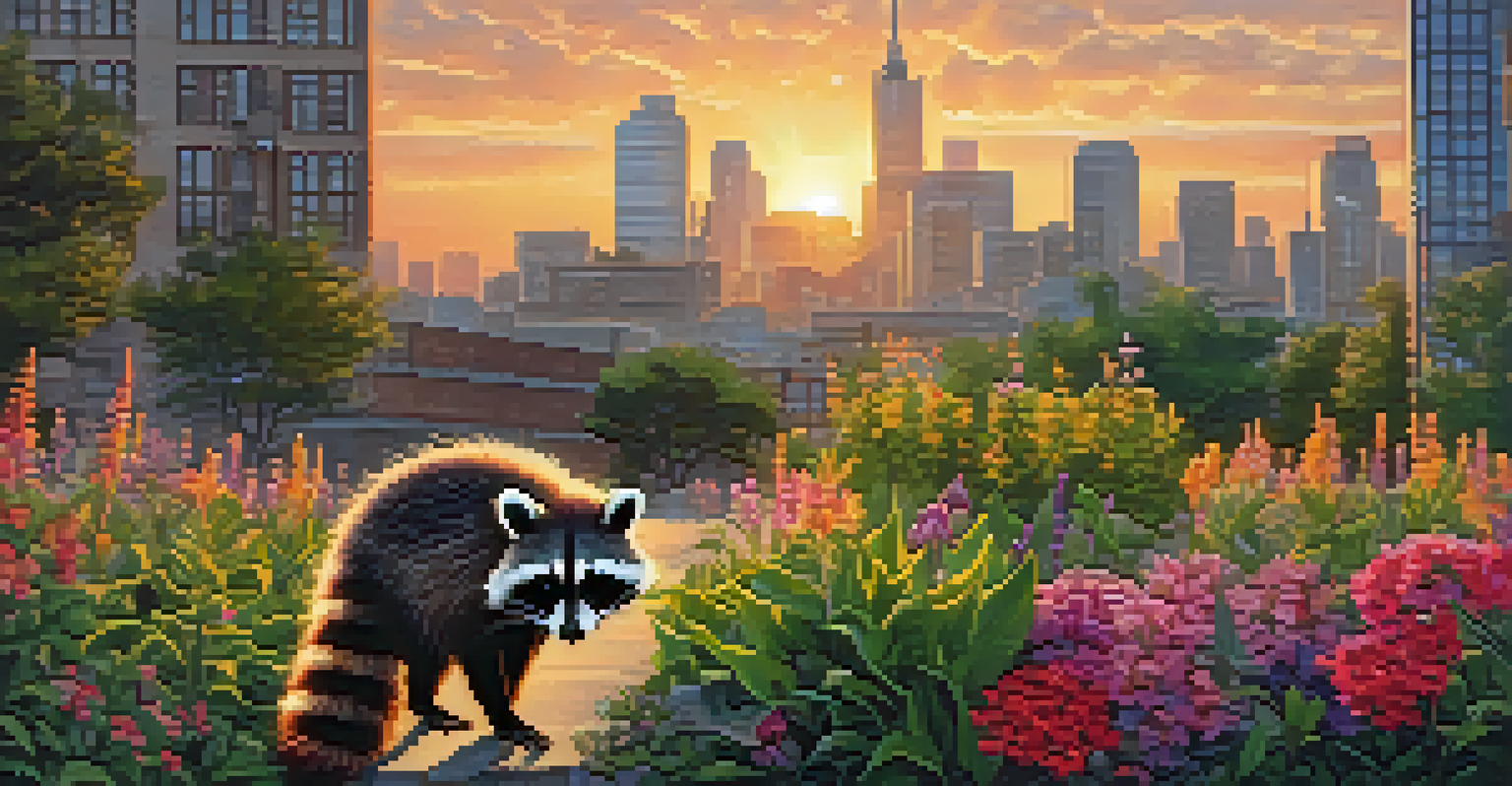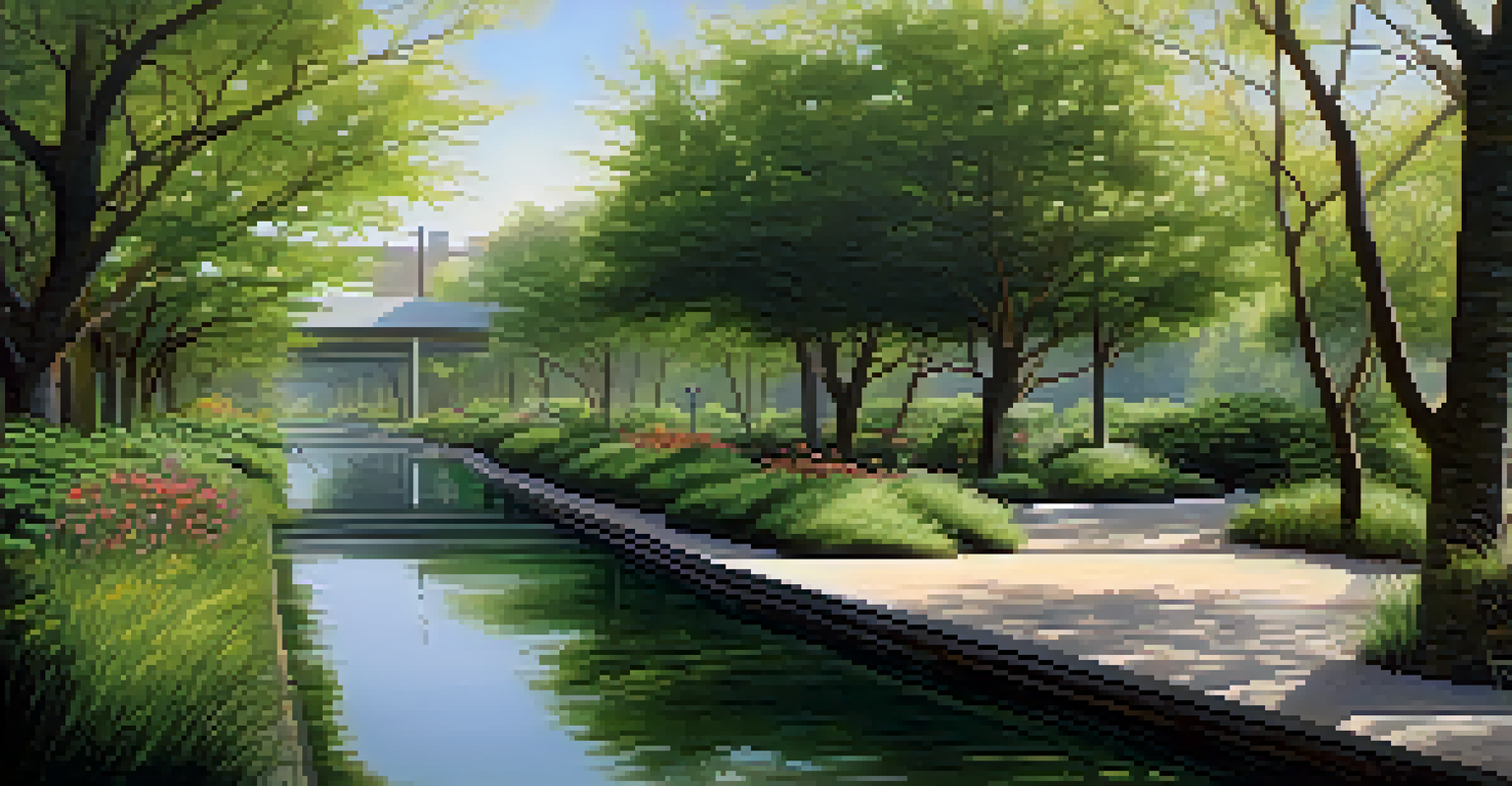The Role of Green Spaces in California's Urban Wildlife

Understanding Urban Wildlife in California's Cities
Urban wildlife refers to the various animal species that adapt to city environments. In California, cities like Los Angeles and San Francisco are home to a surprising diversity of wildlife, from raccoons to peregrine falcons. These animals have learned to navigate urban landscapes, often relying on green spaces for their survival.
In every walk with nature one receives far more than he seeks.
These urban green spaces, including parks and gardens, provide essential habitats for wildlife. They serve as refuges where animals can find food, shelter, and breeding grounds away from the hustle and bustle of city life. This interaction helps maintain the ecological balance in heavily populated areas.
Moreover, urban wildlife contributes to the overall health of ecosystems. By pollinating plants, dispersing seeds, and controlling insect populations, these animals play crucial roles in their environments. Recognizing their importance is vital for creating sustainable urban areas that support both human and wildlife populations.
The Benefits of Green Spaces for Urban Biodiversity
Green spaces act as a lifeline for urban biodiversity, offering a patchwork of habitats that support various species. In California, community gardens and parks attract not only local birds but also beneficial insects, like bees and butterflies. This rich biodiversity is essential for maintaining healthy ecosystems, even in urban settings.

By fostering diverse plant life, these green areas create microhabitats that cater to different wildlife needs. For example, a park with native plants can provide food and shelter for local birds and insects, promoting a thriving ecosystem. Such biodiversity is not just beneficial for wildlife; it enhances the experience for people who visit these spaces.
Urban Wildlife Thrives in Cities
California's urban areas provide essential green spaces that support diverse wildlife species, contributing to ecological balance.
Additionally, preserving and expanding green spaces can help mitigate the effects of climate change. Urban areas often face challenges like increased temperatures and flooding, but green spaces can reduce heat and improve air quality. This synergy between urban wildlife and green spaces showcases their vital role in city planning and environmental health.
Challenges Facing Urban Wildlife in California
Despite the benefits of green spaces, urban wildlife in California faces significant challenges. Habitat loss due to urban development often reduces the availability of green areas, forcing wildlife into smaller, fragmented spaces. This can lead to decreased populations and reduced genetic diversity, which is crucial for resilience.
The earth has music for those who listen.
Pollution is another major concern for urban wildlife. Contaminated water sources and air quality can harm animals directly or disrupt their food chains. For instance, birds that rely on clean waterways for feeding may struggle when these habitats become polluted, affecting their health and survival.
Moreover, interactions between wildlife and humans can lead to conflicts. Animals venturing into urban areas in search of food can encounter dangers like traffic or aggressive pets. Educating the public about coexisting with wildlife is essential to mitigate these issues and promote a balanced urban ecosystem.
The Role of Community in Supporting Urban Wildlife
Community involvement plays a pivotal role in creating and maintaining green spaces that support urban wildlife. Local initiatives, such as tree planting and habitat restoration projects, can have a significant impact on enhancing biodiversity. When residents come together to care for their green spaces, they foster healthier ecosystems.
Education is also key in this effort. By teaching community members about the importance of urban wildlife and how they can contribute, more people will be motivated to participate in conservation efforts. Workshops and events can help raise awareness about the benefits of green spaces for both wildlife and human well-being.
Community Efforts Enhance Biodiversity
Local initiatives and education are crucial for creating and maintaining green spaces that benefit both urban wildlife and residents.
Additionally, community gardens can serve as vital habitats while promoting sustainability. These gardens not only provide food but also create spaces for wildlife to thrive. By incorporating native plants and eco-friendly practices, communities can enhance their local ecosystems and support urban wildlife.
Designing Urban Spaces for Wildlife Conservation
Designing urban spaces with wildlife in mind can significantly enhance biodiversity. Incorporating native plants into landscaping provides food sources and habitats for local species. Using features like birdhouses, bee hotels, and water sources can create inviting environments for wildlife, encouraging them to thrive in urban areas.
Moreover, cities can implement green corridors that connect isolated patches of habitat. These corridors allow wildlife to move safely between green spaces, which is crucial for genetic diversity and overall ecosystem health. They can include parks, green roofs, and community gardens, creating a network of habitats throughout the city.
Urban planning that prioritizes wildlife conservation is not just beneficial for animals; it enriches the lives of residents. Access to green spaces improves mental health and fosters community engagement. By designing cities with both people and wildlife in mind, we can create vibrant urban ecosystems.
The Impact of Climate Change on Urban Wildlife
Climate change poses a significant threat to urban wildlife in California, affecting their habitats and food sources. Rising temperatures can alter the delicate balance of ecosystems, making it challenging for species to adapt. For instance, some migratory birds may struggle to find suitable nesting sites as their preferred habitats shift.
Furthermore, extreme weather events, such as droughts or heavy rainfall, can have devastating effects on urban wildlife. These conditions can lead to habitat destruction and reduced food availability, impacting animal populations. Understanding these challenges is critical for developing effective conservation strategies.
Climate Change Threatens Urban Species
Rising temperatures and extreme weather pose significant challenges to the survival of urban wildlife, necessitating proactive conservation strategies.
To combat these issues, cities can implement climate-resilient practices in their green spaces. Creating water-efficient landscapes and preserving natural areas can help support urban wildlife amidst changing climate conditions. By proactively addressing climate change, we can protect the delicate balance of urban ecosystems.
Conclusion: The Future of Urban Wildlife in California
The future of urban wildlife in California hinges on our commitment to preserving green spaces. As cities continue to grow, it’s crucial to integrate wildlife conservation into urban planning. By prioritizing green areas, we can create environments where both people and wildlife can flourish.
Community engagement and education will play vital roles in this journey. By fostering a culture of conservation, we can inspire future generations to value and protect urban wildlife. Every effort counts, whether it’s planting a tree or participating in local conservation initiatives.

Ultimately, the coexistence of urban wildlife and human populations can lead to healthier ecosystems and enriched urban experiences. Embracing our role as stewards of the environment will ensure that California’s urban wildlife not only survives but thrives in the years to come.